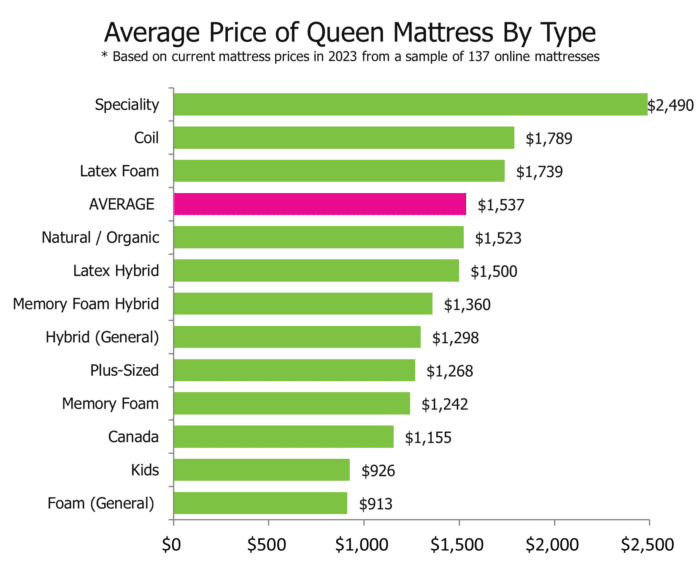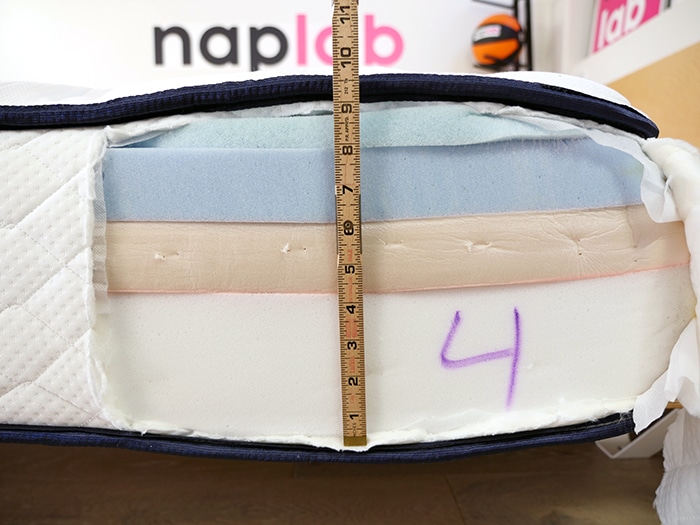Most mattresses should be replaced every 8 to 10 years. However, the mattress type, how it has been cared for, the bed foundation, and how the mattress has been used greatly impact the lifespan of the mattress.
In this guide we’re going to discuss how often you should replace your mattress and mattress durability issues to watch out for. Let’s dive in.
How long do different mattress types last?
Material type is one of the most important factors in determining the lifespan of any mattress, as different materials break down at different speeds
Memory Foam
Lifespan: 8-10 years

Latex Foam
Lifespan: 12-15 years

Innerspring
Lifespan: 6-8 years

Hybrid
Lifespan: 10-12 years

Innerspring mattresses generally have the shortest lifespans at 6-8 years. Many traditional pillow tops (non-euro tops) also typically last 6-8 years. The pillow top itself is usually what breaks down first.
Memory foam and other types of poly foam last 8-10 years.
Hybrid mattresses typically will last 10-12 years.
And lastly, latex is the most durable material, lasting 12-15 years.
How much should I spend on a mattress?
Cheaper mattresses are generally made with lower quality materials that don’t last as long. Regardless of mattress type, a cheap mattress may only last 1-4 years. This is because the materials simply break down more quickly, leading to issues with support and comfort.

Most quality Queen size mattresses start around $1,000. Many mattresses below that price point will be more prone to durability and longevity issues. See our How Much Does a Mattress Cost Guide for more.
What mattress thicknesses are best?
Mattresses that are thicker have more materials within them. These thicker layers mean there is simply more layers creating support and comfort, and more material that would need to degrade before support and comfort decline.

As a result, thicker mattresses usually last longer than thinner mattresses. For most adults, I don’t recommend any mattress thinner than 10″, with mattresses that are 12-14″ thick being far preferable in terms of performance and longevity.
Mattress Longevity Factors
In addition to material type, there are other factors that can age your mattress faster or slower. Three of the most influential factors include:
- Mattress Foundation: A high performance and high quality foundation will ensure the mattress is well supported, reducing sags and body impressions. There are many acceptable foundation types including platforms, slats, foundations, box springs (depends on the mattress), bunkie boards, and more. Always verify with the mattress manufacturer what foundations are compatible, as using an incompatible foundation can void the warranty.
- Body Weight: Your weight will play a role, as heavier sleepers tend to break down material layers faster than lighter sleepers.
- Mattress Care: A mattress that is properly cared for will generally last longer than a mattress that receives no care.
- Frequency of Use: A mattress that you sleep on nightly will generally not last as long as a mattress occasionally used in your guest room.

How to Help Your Mattress Last Longer
Proper maintenance and care can extend the lifespan of a mattress by years if done properly. Here are three of the best ways to help a mattress last longer.
- Use a mattress protector: A mattress protector is a great way to protect from damage, stains, moisture, dirt, and more. In addition, to can help ensure you maintain your mattress warranty, as damaged mattresses can void many mattress warranties.
- Clean the mattress: Cleaning a mattress includes regular maintenance like refreshing the bedding, vacuuming, and spot cleaning as well as deep cleaning and sanitizing as needed.
- Rotate the mattress: Whether you sleep with a partner or sleep alone, rotating the mattress is an important part of making sure the mattress wears evenly. Different sleepers apply pressure differently so when you rotate the mattress you reduce the risk of sagging or indentations forming on the mattress. In general, you want to rotate a mattress every 12 months. Always follow your mattress manufacturer’s guidelines.
How To Know When You Need To Replace Your Mattress
So you think your mattress is near the end of its life? How do you know when it is time to replace it? There are a few signs to look for in an aging mattress that will help you determine when it is no longer right for you.
#1. Signs of visible wear and tear
If the mattress is ripped, torn, or otherwise showing signs of age and use that cannot easily be repaired, it may be time to replace it.

A mattress in this state cannot fully perform at its highest level. Furthermore, big rips and tears could be a breeding ground for bacteria to enter to core of the mattress.
#2. Signs of sagging or indentations
If there are visible sags or lumps on the mattress, it may be time to replace it. Sagging in a mattress is a sign that the material in that spot has failed. This could be foam that does not return to its original position or a coil mattress that has weak push-back.

If you’re a single sleeper, you may be able to rotate the mattress and buy some time, but for couples, this likely is not an option.
Note: Many mattresses protect consumers from excessive sag and sinkage within the terms of the warranty. Sinkage deeper than 2.0″ is oftentimes protected.
#3. Decrease in sleep quality
If you find yourself waking up in the middle of the night or are noticeably more tired in the morning than usual, these are signs that you aren’t getting the quality of sleep you need.

An old mattress that you’re tossing and turning on could easily be the culprit for this sudden change in sleep quality.
#4. New allergies or irritants
If you’ve suddenly developed new allergies and it’s not tied to seasonal changes, you may need to replace your mattress. As your mattress ages, it can become a breeding ground for dust mites, bacteria, allergens, or even bed bugs.

While proper care can greatly limit these allergens, it can be difficult to limit them entirely.
What to look for in a new mattress?
When shopping for a new mattress, think about what you’re looking for. For most sleepers, it’s going to be a comfortable sleeping surface that also provides adequate support.
Different material types can provide different levels of support and feel. Firmness will also play a role.
For the longest-lasting mattress, I would generally recommend a hybrid mattress. Here are the top-performing hybrid mattresses we’ve tested to date.
| Mattress | Score | Firmness | Read Review | Check Price |
|---|---|---|---|---|
| Winkbed | 9.82 | 4, 6, or 7 | Read Review | Check Price |
| Diamond Flurry Lux | 9.32 | 4 or 6 | Read Review | Check Price |
| Helix Midnight Elite | 9.24 | 5.5 | Read Review | Check Price |
| Nolah Evolution 15 | 9.28 | 4, 5.5, 8 | Read Review | Check Price |
| Nest Bedding Sparrow | 9.20 | 3.5, 5, or 8 | Read Review | Check Price |
For more budget-friendly picks (under $1000), I would opt for one of the following:
| Mattress | Type | Score | Firmness | Read Review | Check Price |
|---|---|---|---|---|---|
| Douglas | Foam | 9.02 | 6 | Read Review | Check Price |
| BedInABox Original | Foam | 8.79 | 6 | Read Review | Check Price |
| Brooklyn Bedding Signature | Hybrid | 8.85 | 4, 6, or 8 | Read Review | Check Price |
| Zoma (Hybrid) | Hybrid | 8.89 | 5 | Read Review | Check Price |
| GhostBed Classic | Foam | 8.76 | 6.5 | Read Review | Check Price |


